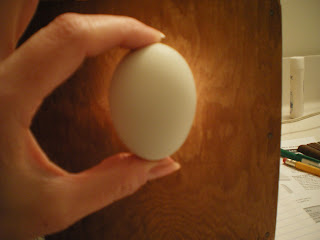This morning we set up the candler and checked the eggs for life. A candler, for those of you who are unfamiliar with the term, is a gadget used to focus a light so that one may see the shadow of a developing chick. It can be as simple as a LED flashlight shining through a hole in a can or, in our case, a birdhouse box with a 100 watt bulb screwed into the bottom.
By holding the egg in front of the lighted hole, the developing chick looks like a freckle surrounded by reddish veins spidering away onto the yoke. It was relatively easy to read the lighter blue shelled eggs. The darker shelled ones are more of a challenge. To confirm we'll try again in another few days.
I don't have a camera to show you what I saw so I made a sketch for you:
The pocket on top is an air space between the shell and shell membrane that the developing chick needs to breathe. The shell on the air end is more porous allowing gases to exchange while keeping out bacteria and other nasties. When the chick hatches, this air pocket may provide the chick with its first breath.
For those who want more science-y info on hatching chicks, check the following link: http://chickscope.beckman.uiuc.edu/resources/egg_to_chick/formation.html
By holding the egg in front of the lighted hole, the developing chick looks like a freckle surrounded by reddish veins spidering away onto the yoke. It was relatively easy to read the lighter blue shelled eggs. The darker shelled ones are more of a challenge. To confirm we'll try again in another few days.
I don't have a camera to show you what I saw so I made a sketch for you:
The pocket on top is an air space between the shell and shell membrane that the developing chick needs to breathe. The shell on the air end is more porous allowing gases to exchange while keeping out bacteria and other nasties. When the chick hatches, this air pocket may provide the chick with its first breath.
For those who want more science-y info on hatching chicks, check the following link: http://chickscope.beckman.uiuc.edu/resources/egg_to_chick/formation.html









